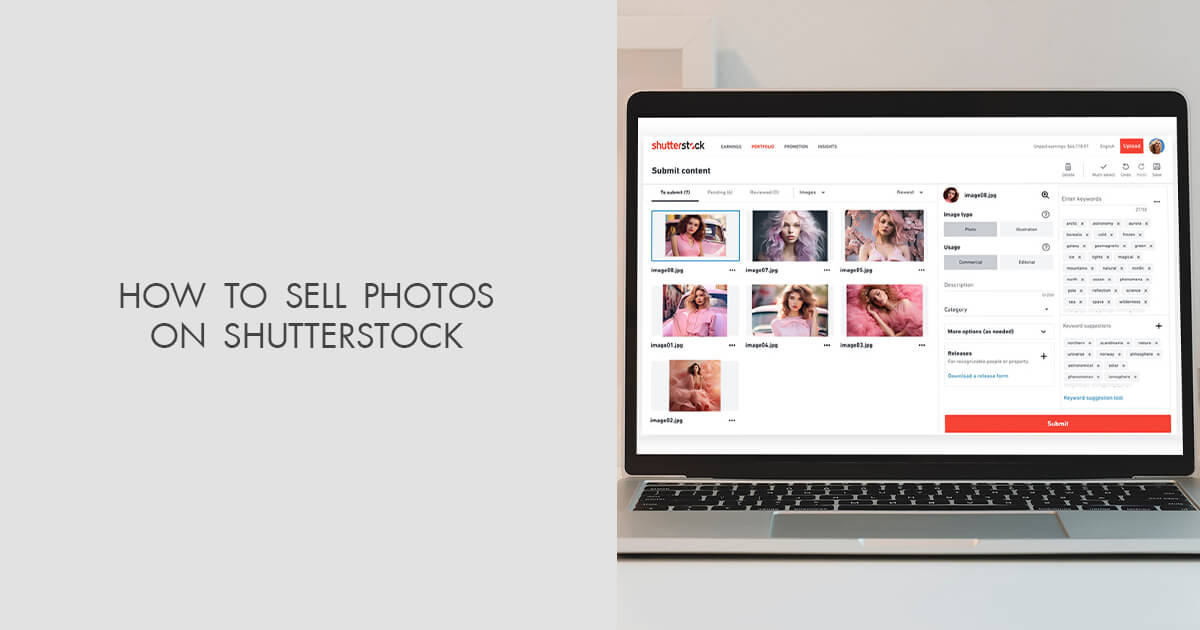Thinking about turning your creative work into a steady stream of passive income? Selling content on Shutterstock might just be the perfect way to do that! Whether you’re a photographer, graphic designer, or videographer, Shutterstock offers a platform to showcase your talents to millions of potential buyers worldwide. The best part? Once your content is uploaded and approved, it can generate royalties over and over again without much extra effort. So, if you’re ready to start monetizing your creativity and earn some extra income, let’s dive into how you can make the most of
Understanding Shutterstock’s Platform and Requirements

Before you jump into uploading your content, it’s important to get familiar with how Shutterstock operates and what they look for in submissions. Shutterstock is one of the largest stock content platforms, with a massive global audience eager for high-quality images, videos, and illustrations. But not every piece of content makes the cut — quality and compliance are key.
Here are some critical aspects to keep in mind:
- Content Types Accepted: Shutterstock welcomes a variety of content including photos, vector illustrations, videos, and 3D models. Each type has its own specifications, so be sure to review their guidelines for each.
- Quality Standards: Your uploads should be high-resolution, well-lit, and free of noise or blurriness. For images, a minimum of 4 megapixels is typically required, but higher quality is always better.
- Model and Property Releases: For images featuring recognizable people or private property, you need proper releases. Shutterstock provides templates and guidance on securing these.
- Legal and Copyright Compliance: Your content must be original and not infringe on copyrights. Avoid adding logos, watermarks, or copyrighted materials unless you have permission.
In terms of the submission process, Shutterstock uses a straightforward review system. Once you upload your files, they are evaluated by their review team, which checks for quality, adherence to guidelines, and legal compliance. While it might seem strict, this process helps maintain a high standard, increasing your chances of acceptance and sales.
Getting familiar with these platform requirements upfront will save you time and frustration. Remember, the goal is to create content that stands out in quality and complies fully with Shutterstock’s standards — that’s the best way to ensure your work is accepted and starts earning you passive income.
Preparing Your Content for Submission

Before you hit that submit button on Shutterstock, taking the time to prepare your content properly is key. Think of it like getting ready for a big date — you want everything to look polished and professional. First things first, make sure your images and videos are high quality. Shutterstock has strict standards, so blurry, pixelated, or poorly lit content probably won’t make the cut.
Start by reviewing Shutterstock’s technical requirements. For images, they usually recommend a minimum resolution of 4 megapixels, but higher is always better. For videos, aim for at least 1080p quality. Also, check your file formats: JPEG for images and MOV or MP4 for videos are typically accepted.
Next, consider the content itself. Make sure your images are visually appealing and relevant. Remove any watermarks, logos, or distracting elements unless they’re part of your creative concept. For videos, trim any unnecessary parts and ensure the footage flows smoothly. It’s also a good idea to organize your files clearly, labeling them with descriptive names that include keywords. This makes your submission process smoother and helps with future searches.
Don’t forget about model and property releases if your content features recognizable people or private property. Shutterstock requires these releases to protect copyright and privacy rights. Gather these documents beforehand to avoid delays in approval.
Finally, consider adding keywords and descriptions to your files. Use relevant, specific keywords that accurately describe your content. Think about what a buyer might search for — this boosts your chances of your content being discovered. Take your time with this step; well-optimized metadata can significantly impact your sales.
Tips for Creating High-Quality Images and Videos

Creating content that stands out on Shutterstock isn’t just about snapping a photo or hitting record — it’s about quality, creativity, and attention to detail. Here are some tips to help you produce images and videos that catch the eye and meet platform standards.
Focus on Lighting: Natural light is your best friend. Shoot during the golden hour — the hour after sunrise or before sunset — for warm, soft lighting that adds depth and richness. Avoid harsh midday sun unless you’re going for a stark, high-contrast look. For videos, good lighting ensures clarity and reduces noise.
Composition Matters: Use the rule of thirds to create balanced, engaging shots. Keep your horizon straight, and avoid cluttered backgrounds unless they add context. Think about the story you want to tell; a well-composed shot draws viewers in.
Use a Good Camera: While you don’t need a professional DSLR, using a decent camera or smartphone with a high-resolution sensor makes a difference. Stabilize your shots with a tripod or gimbal to prevent shaky footage. Clear, sharp images and videos are more likely to be accepted and sold.
Pay Attention to Details: Small touches can elevate your content — clean your lens regularly, remove distracting elements from the frame, and ensure your subject is in focus. For videos, plan your shots and movements to create smooth transitions and avoid abrupt camera movements.
Edit Thoughtfully: Post-processing can enhance your content, but don’t overdo it. Use editing software to adjust brightness, contrast, and colors for a natural look. For videos, consider color grading and sound editing to improve overall quality.
Be Unique and Creative: Trends come and go, but original content always stands out. Think outside the box — experiment with angles, themes, and concepts that are fresh and engaging. Unique content has a better chance of getting noticed and earning sales.
By focusing on these tips and maintaining high standards, you’ll produce content that not only meets Shutterstock’s guidelines but also excites potential buyers. Remember, the better your content looks, the more passive income you can generate over time!
Uploading and Tagging Your Content Effectively

Alright, so you’ve created some fantastic content—whether it’s stunning photos, eye-catching illustrations, or sleek videos. Now, the next step is making sure your work gets noticed by the right audience. That’s where uploading and tagging come into play. Getting this right can really boost your visibility and sales on Shutterstock.
First things first: uploading your content. Shutterstock has a user-friendly submission platform. Before you upload, double-check your files—make sure they’re high quality, properly formatted, and meet Shutterstock’s technical requirements. For images, this usually means high-resolution JPEGs with a minimum of 4 MP, and for videos, ensure they’re in the supported formats with good audio and visual quality.
When you’re ready to upload, consider batch uploading if you have multiple pieces. It saves time and helps keep your workflow efficient. During upload, Shutterstock prompts you to fill in details like title, description, and tags. This is where effective tagging becomes crucial.
Maximizing Your Earnings with Shutterstock Sales Strategies
Now that your content is uploaded and ready to go, it’s time to think about how to maximize your earnings. Shutterstock isn’t just about uploading; it’s about smart selling strategies that put your work in front of more buyers and turn your uploads into a steady stream of income.
Here are some key tips to boost your earnings:
- Optimize Your Metadata: Use descriptive, relevant titles and descriptions. Think about what buyers might search for—use common keywords and avoid keyword stuffing. Clear, accurate descriptions help your content appear in the right search results.
- Use Effective Tags: Tags are like keywords that help your content get discovered. Include a mix of broad and specific tags. For example, if you upload a photo of a sunset over mountains, include tags like “sunset,” “mountains,” “nature,” “landscape,” and specific ones like “Alpine sunset” if relevant.
- Leverage Trends and Seasons: Keep an eye on current trends, holidays, and seasons. Creating content around these themes can lead to higher sales. For example, stock images of holiday decorations or summer scenes tend to sell well during peak seasons.
- Update Regularly: Consistently add new content to your portfolio. The more fresh content you have, the more chances you have to appear in searches and attract repeat buyers.
- Participate in Shutterstock Contributor Contests: These contests can give your work extra visibility and sometimes come with monetary prizes. They’re also a fun way to challenge yourself and stay motivated.
- Promote Your Portfolio: Share your Shutterstock profile on your social media or website. The more exposure your work gets, the higher the chances of sales.
Remember, the key to maximizing earnings is a combination of quality, relevance, and visibility. Keep refining your tags and descriptions based on what’s trending and what buyers are searching for. With patience and strategic effort, your Shutterstock portfolio can become a reliable source of passive income over time.
Monitoring Your Performance and Optimizing Your Portfolio
So, you’ve started uploading your fantastic content to Shutterstock—congratulations! But the journey doesn’t end there. To truly maximize your passive income potential, you need to keep a close eye on how your portfolio is performing and make smart adjustments along the way. Think of it as tending a garden—regular care and tweaks help your plants thrive.
First, get familiar with Shutterstock’s Contributor Dashboard. This is your command center where you can see detailed stats like views, downloads, and earnings for each piece of content. Use these insights to understand what’s resonating with buyers. For example, if a particular photo or illustration is consistently getting downloads, consider creating similar content or variations to capitalize on that trend.
Here are some practical tips for monitoring and optimizing your portfolio:
- Analyze Your Best Performers: Identify which images or videos are generating the most income. Look at factors like subject matter, style, and keywords.
- Update and Refresh Content: If certain assets aren’t performing well, consider updating their metadata—titles, descriptions, and keywords—to improve discoverability.
- Expand on Successful Themes: If a particular niche or style does well, create more content around it to attract a dedicated audience.
- Experiment and A/B Test: Upload variations of popular content to see which versions perform better. Slight tweaks in color, composition, or keywords can sometimes make a big difference.
- Stay Current with Trends: Keep an eye on market trends and seasonal demand. For instance, holiday-themed content tends to spike at certain times of the year.
Consistency is key. Regularly reviewing your stats and making informed adjustments ensures your portfolio stays relevant and profitable. Remember, passive income is all about working smarter, not harder. The more you understand what works, the better your chances of passive earnings flowing in over time.
Legal Considerations and Copyright Compliance
One of the most critical aspects of selling content online—especially on a platform like Shutterstock—is understanding legal considerations and ensuring copyright compliance. It’s tempting to just upload whatever you’ve created, but the truth is, respecting intellectual property rights keeps you out of legal trouble and maintains your reputation as a trustworthy contributor.
Let’s break down some key points:
- Own Your Content: Only upload images, videos, or illustrations that you have created yourself or for which you hold the legal rights. If you use elements created by others, you need explicit permission or licenses.
- Model Releases: If your content features recognizable people, you must obtain a signed model release form. This grants permission for commercial use and protects both you and Shutterstock.
- Property Releases: For content depicting private property, artworks, or trademarks, securing a property or property release is essential. Without it, your asset might be rejected or taken down.
- Copyrighted Material: Avoid including copyrighted logos, brands, or protected artwork unless you have explicit permission. Using such content can lead to takedowns, account suspension, or legal action.
- Attribution and Licensing: Understand the licensing options Shutterstock offers. Your content will be licensed under specific terms, and you should be clear about what rights you are granting to buyers.
To stay compliant:
- Always read and adhere to Shutterstock’s Contributor Agreement and submission guidelines.
- Keep documentation of model and property releases in case of future disputes.
- Regularly review your uploaded content to ensure ongoing compliance, especially if laws or platform policies change.
- When in doubt, consult legal resources or professionals specializing in intellectual property law.
Remember, respecting copyright isn’t just about avoiding legal trouble—it’s about maintaining your reputation as a creator who values integrity. This trust can lead to more opportunities and a sustainable passive income stream on Shutterstock. Play it safe, stay informed, and your content journey will be smoother and more rewarding!
Conclusion and Next Steps for Successful Passive Income Generation
Achieving consistent passive income through selling content on Shutterstock requires dedication, strategic planning, and ongoing effort. By understanding the platform’s requirements and optimizing your submissions, you can unlock a steady revenue stream that grows over time. Remember, success doesn’t happen overnight—patience and persistence are key.
To maximize your earning potential, consider the following next steps:
- Research Trends: Stay updated with current content trends to create relevant and in-demand assets.
- Build a Diverse Portfolio: Offer a variety of high-quality images, vectors, videos, and illustrations to attract different buyers.
- Optimize Your Listings: Use descriptive, keyword-rich titles and tags to improve discoverability.
- Maintain Consistency: Regularly upload new content to keep your portfolio fresh and engaging.
- Engage with the Community: Participate in forums and follow Shutterstock’s content guidelines to enhance your visibility and credibility.
By following these steps and continuously refining your content creation process, you can build a sustainable passive income stream on Shutterstock. Remember, the key is consistency, quality, and staying adaptable to market demands. Start today, and watch your passive income grow over time!


